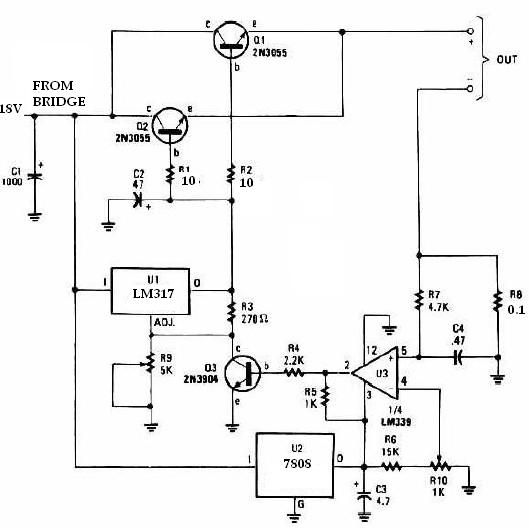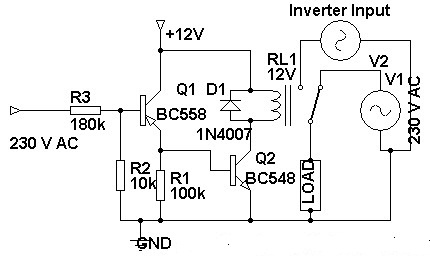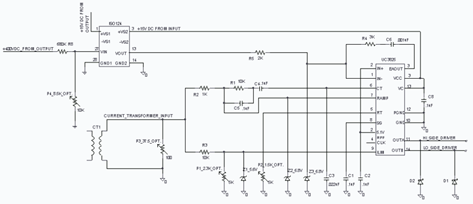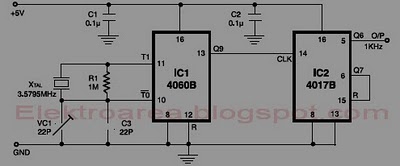
555 meter circuit diagram of the analog information Qigong
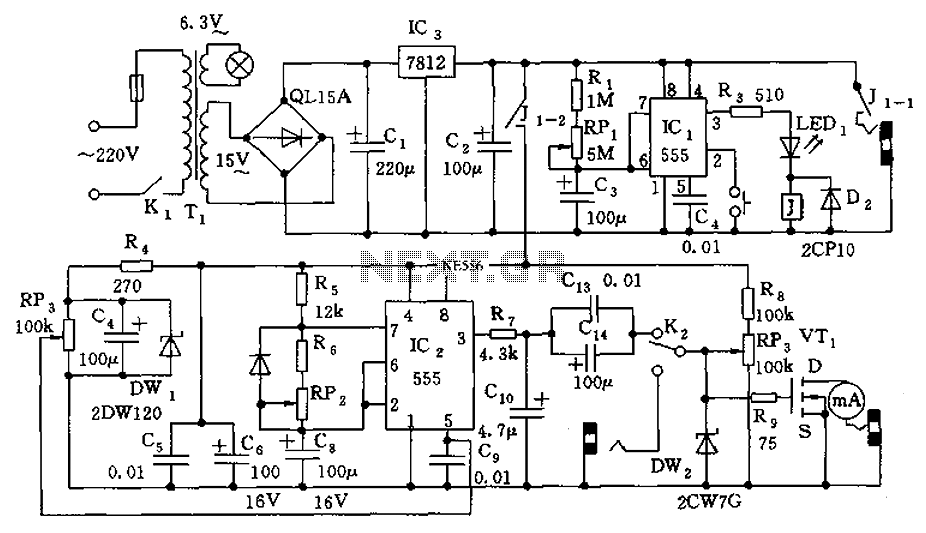
The information apparatus includes a buck rectifier power supply providing Vdd at +12V, a timing circuit, a multivibrator, and the output from the first amplifier. The components R1, RP1, and C3 are used to initiate timing, with the timing duration defined as td = 1.1(R1 + RP1)C3. During the timing phase, J pull controls the connections of contacts J1-1 and J1-2. The multivibrator is managed by IC2 along with components R5, R6, RP2, and C8, where the frequency is determined by the formula f = 1.44/(R5 + 2R6 + RP2)C8. This frequency can be adjusted by adding a control voltage via a 5-pin connector, specifically through the adjustment of RP3. VT1 is a V-MOS field-effect power transistor. The output head utilizes a 0.85μm GaAs semiconductor laser and is designed with infrared radiation capabilities using PTC special ceramic material, alongside strong magnetic fields generated by SmCo magnets.
The described apparatus is a sophisticated electronic system that integrates several key components to achieve its operational goals. The buck rectifier power supply is essential for converting higher voltage levels down to a stable +12V, which is necessary for powering the subsequent circuitry. The timing circuit is crucial for establishing precise intervals for operation, with R1, RP1, and C3 forming a timing network that determines the duration of the timing cycle. The timing calculation, td = 1.1(R1 + RP1)C3, indicates that the timing duration is influenced by the resistance values of R1 and RP1, as well as the capacitance of C3.
The control mechanism involving J pull and the connections at J1-1 and J1-2 suggests that the timing circuit may interface with other parts of the system, enabling or disabling functions based on the timing state. The multivibrator, managed by IC2 and supported by resistors R5, R6, RP2, and capacitor C8, generates oscillations at a frequency defined by the equation f = 1.44/(R5 + 2R6 + RP2)C8. This configuration allows for flexibility in frequency modulation, which can be fine-tuned through the addition of a control voltage at the 5-pin connector, specifically by adjusting RP3.
The use of a V-MOS field-effect power transistor (VT1) enhances the power handling capabilities of the circuit, enabling efficient switching and amplification of signals. The output head's design, incorporating a 0.85μm GaAs semiconductor laser, indicates a focus on applications requiring infrared radiation, which is facilitated by the PTC special ceramic material. This setup, combined with the strong magnetic fields produced by SmCo magnets, suggests that the apparatus is designed for applications in fields such as telecommunications, laser-based systems, or other advanced electronic applications where precise timing and control are critical. As shown, the information apparatus comprises buck rectifier power supply (Vdd + 12V), the timing circuit, multivibrator, the output of the first amplifier and function. IC1 an d R1, RP1, C3 composition start timing, timing td 1.1 (R1 + RP1) C3. In the timing, J pull, control J1-1, J1-2 contacts connected. IC2 and R5, R6, RP2, C8 and other components controlled multivibrator, f 1.44/(R5 + 2R6 + RP2) C8, but the frequency can be changed by adding 5 feet in control voltage, namely by adjusting to RP3 achieve. VT1 using V-MOS field-effect power transistor. Function output head adopts 0.85um GaAs semiconductor laser and infrared radiation PTC special ceramic material, and a strong magnetic field SmCo magnets.
The described apparatus is a sophisticated electronic system that integrates several key components to achieve its operational goals. The buck rectifier power supply is essential for converting higher voltage levels down to a stable +12V, which is necessary for powering the subsequent circuitry. The timing circuit is crucial for establishing precise intervals for operation, with R1, RP1, and C3 forming a timing network that determines the duration of the timing cycle. The timing calculation, td = 1.1(R1 + RP1)C3, indicates that the timing duration is influenced by the resistance values of R1 and RP1, as well as the capacitance of C3.
The control mechanism involving J pull and the connections at J1-1 and J1-2 suggests that the timing circuit may interface with other parts of the system, enabling or disabling functions based on the timing state. The multivibrator, managed by IC2 and supported by resistors R5, R6, RP2, and capacitor C8, generates oscillations at a frequency defined by the equation f = 1.44/(R5 + 2R6 + RP2)C8. This configuration allows for flexibility in frequency modulation, which can be fine-tuned through the addition of a control voltage at the 5-pin connector, specifically by adjusting RP3.
The use of a V-MOS field-effect power transistor (VT1) enhances the power handling capabilities of the circuit, enabling efficient switching and amplification of signals. The output head's design, incorporating a 0.85μm GaAs semiconductor laser, indicates a focus on applications requiring infrared radiation, which is facilitated by the PTC special ceramic material. This setup, combined with the strong magnetic fields produced by SmCo magnets, suggests that the apparatus is designed for applications in fields such as telecommunications, laser-based systems, or other advanced electronic applications where precise timing and control are critical. As shown, the information apparatus comprises buck rectifier power supply (Vdd + 12V), the timing circuit, multivibrator, the output of the first amplifier and function. IC1 an d R1, RP1, C3 composition start timing, timing td 1.1 (R1 + RP1) C3. In the timing, J pull, control J1-1, J1-2 contacts connected. IC2 and R5, R6, RP2, C8 and other components controlled multivibrator, f 1.44/(R5 + 2R6 + RP2) C8, but the frequency can be changed by adding 5 feet in control voltage, namely by adjusting to RP3 achieve. VT1 using V-MOS field-effect power transistor. Function output head adopts 0.85um GaAs semiconductor laser and infrared radiation PTC special ceramic material, and a strong magnetic field SmCo magnets.
